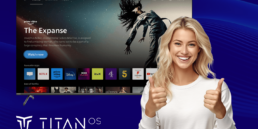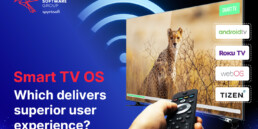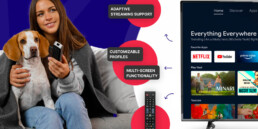Among the many factors impacting consumer decisions to buy one TV over another is the operating system (or platform) it runs. This is especially important concerning the ease of use and compatibility with the user’s favorite apps and devices. And while most people have heard about Android TV, webOS is relatively lesser-known. However, it’s not less capable and has been gaining traction recently.
Until recently, webOS was only available on LG TV. The word “only” might be an understatement as LG Electronics enjoys an impressive 16 percent of the TV market share. Even more so, it makes sense to learn about what this platform is, what it offers, and how it performs.
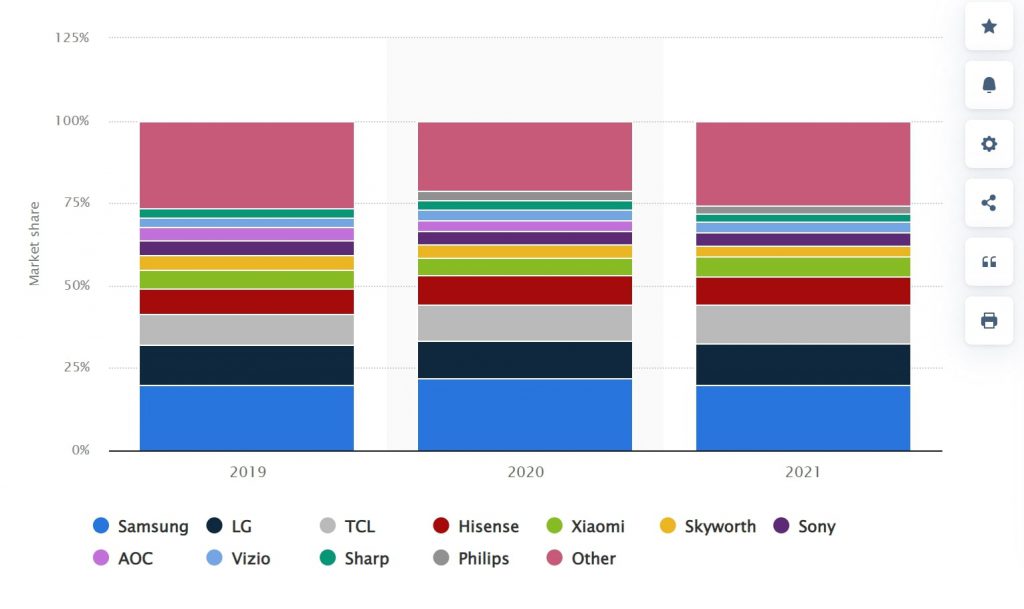
2019-2021 market share by TV manufacturers (Source: Statista)
What is webOS?
WebOS is an LG-owned, Linux-based operating system that was originally seen only on LG-branded smart TVs. This is bound to change in the coming years as the South-Korean giant has recently partnered with other manufacturers in a focused effort to put the system on a wider range of devices.
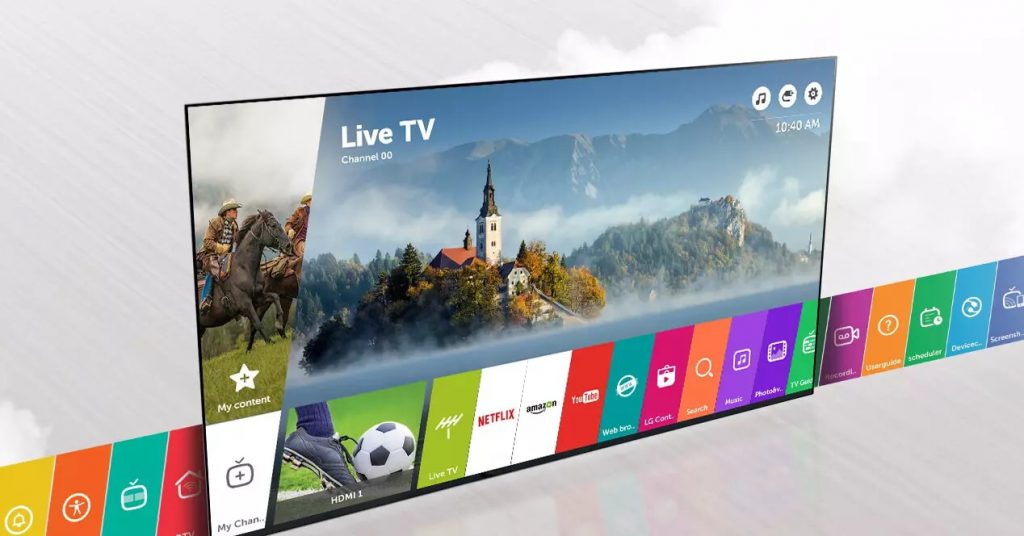
Old webOS interface (app ribbon)
LG also intends to use webOS in other smart appliances, and the company has not ruled out future use in smartphones. This is not necessarily a pipe dream – WebOS was originally used in Palm and HP smartphones and was open source until LG purchased the platform in 2013 adapting it for use in their smart TVs.
The 2021 redesign of webOS
LG’s webOS recently received a UI update. Gone are the days of the minimalistic interface, with the ribbon-like customizable launch bar occupying the bottom of the screen. Since 2021, LG TVs are offered with webOS version 6.0 on board, sporting a completely different look. Among other things, the trademark bottom launch bar has been removed altogether. Now, the webOS UI fills the screen with rows of large banners, app lists, content recommendations, and a home dashboard. This is a familiar design, not unlike the big competitors Android TV or Apple TV.

In 2021, LG launched its first OLED, QNED Mini LED, NanoCell, and UHD smart TV models featuring the new version of webOS UI.
The benefits of webOS
WebOS is a developer-friendly platform that offers powerful capabilities for creating feature-rich web apps and is based on technologies developers love, like HTML, JavaScript, and CSS.
Generally, WebOS is a smart platform that can be configured to your liking. The launch bar can be brought up without exiting the current app, unlike on Android TV. This makes app switching on LG’s webOS much more fluid.
In webOS, you’ll also see a row of cards corresponding to each app as you scroll through the options in the launch bar. When you hover over the LG Content Store in the launch bar, an additional row of cards will appear showing suggested app downloads.
webOS TV system components
WebOS TV is built around a set of essential services that let apps manage media, devices, security, networking, and TV functions.
Through the System Bus, the apps on webOS TV can communicate with the available services. App Manager, Media, etc., are examples of webOS services that apps can access through the webOS TV System Bus. Apps can also access custom services provided by 3rd party developers through the System Bus.
Web Apps
WebOS web apps are very similar to standard web apps. The webOS TV platform supports standards-based web technologies such as HTML, CSS, and JavaScript. Anyone with experience in building web applications can easily start developing web apps for webOS TV. Apps for LG’s webOS Can be implemented by various JavaScript app frameworks such as Enact, jQuery, and more.
Web apps running on the webOS platform are delivered in two models:
- Packaged web apps, along with all the resources they need to work successfully, are stored on the TV.

Packaged web apps (source: LG)
- Hosted web apps, which reside on a remote web server. Hosted web apps require secure connections with the server to obtain the content successfully, which can be considered a constraint for this application type because the actual resources of the app reside on a remote server. The app and its content can also be updated at any time without having to worry about pushing updates to the webOS TV devices.

Hosted webOS apps (source: LG)
JavaScript Services
webOS TV supports JavaScript services created using Node.js. These services can perform background processing, low-level networking, and access to the file system, among other tasks. Apps access the webOS JavaScript services through the webOS TV System Bus.
Connect SDK
LG’s Connect SDK is an open-source framework developed to connect mobile apps to multiple TV platforms. Connect SDK is a tool to help webOS TV apps be promoted through mobile apps.
What’s in it for the users: app availability
WebOS app availability is meager next to Android TV, but you won’t even feel it as many popular streaming apps are pre-installed, including YouTube, Netflix, Amazon Prime Video, Disney Plus, Google Play Movies, and TV. Additional apps can be downloaded from the LG Content Store.

LG Content Store (source)
There are not many app stores where you don’t need to sign up for an account, but the LG Content Store is one of them. That’s a great advantage, as you have a few accounts as possible. The options of the Dutch ThinQ AI are unfortunately still limited. In other countries, the voice assistant does answer questions about the weather. So future updates are something to look forward to.
Using the LG TV Plus app
With the LG TV Plus app, you can turn your smartphone or tablet into a TV remote. This gives you control over all the basic functions, such as volume control and arrow keys. You can navigate between apps and channels. You can just as easily select a connected source, such as a Blu-ray player or digital decoder. The app is especially useful when you also use your smartphone to stream content to the TV.
Stream and cast content
You can stream photos or videos from your smartphone or tablet to the TV via the LG TV Plus app. Some apps like YouTube have a casting option. In this case, you don’t send content, but a link to the TV. The TV then opens the video in its own app. As a result, the aspect ratio is perfect and you can use your smartphone for other things. OLED and NanoCell TVs from 2019 have AirPlay. With this feature, you can stream images and music via an iPhone or iPad.
LG Magic Remote
LG’s Magic Remote is a great accessory and one of the strongest points of LG TVs. It comes with all LG OLED TVs and many LCD TVs. However, if your LG TV doesn’t come with one, it can still be bought separately (and used if the TV is compatible).
LG’s Magic Remote works like a screen pointer making navigation and text typing on an LG TV much easier compared to, for example, the Android TV platform. The buttons can be programmed to work as shortcuts for different apps. This is a level of customization that’s still absent from Android TV.
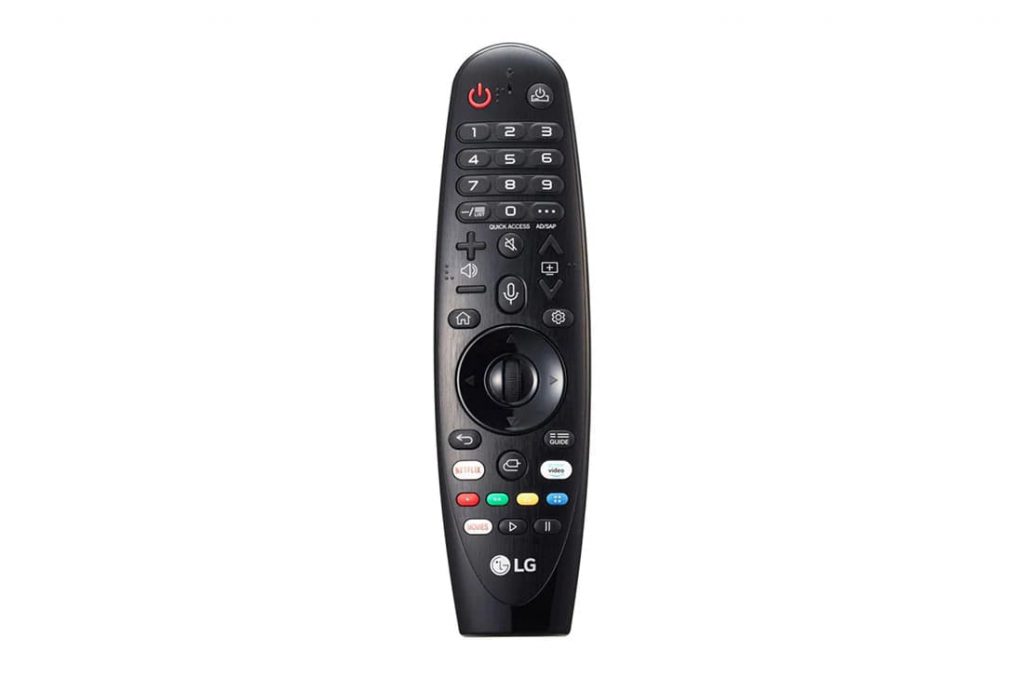
LG’s 2019 Magic Remote
Voice control
The Magic Remote also offers voice search just like most Android TV remotes. If you hold down the microphone button on your remote, you activate the ThinQ AI voice assistant. The Dutch version isn’t yet as complete as the American one, for example. At this point, you can mainly use the function to speak search commands. After each command, a list appears in the menu. This list contains relevant websites and videos from YouTube and other video services.
So, is it worth developing apps for webOS?
Definitely, as LG is now allowing third-party TV manufacturers to include webOS on their products. Already, Ayonz, Konka, and RCA are using the operating system. LG’s technology partners also include Nuance, Gracenote, Realtek, Universal Electronics, and more.
WebOS 6’s improved search features and greater OS availability mean now is the time to consider smart TV app development on this platform. With LG webOS TV, hardware partners also get a diversity of content options including access to global streaming service apps such as Netflix, YouTube, Amazon Prime Video and sports streaming service DAZN as well as LG Channels, the company’s free premium content streaming service.

In addition to TV manufacturers, LG has established partnerships with many technology and content providers to significantly grow its presence in the home entertainment market.
Conclusion
Developing apps for smart TVs is certainly not easy and involves many important design decisions, and platform selection is just one of them – read our blog post comparing the leading smart TV platforms here.
Because smart TV app development is still mostly uncharted waters, the importance of partnering with the right development company is even higher. But at the same first-mover’s advantages for businesses are plenty, and TV production companies and brands must seize this opportunity to get ahead of the game.
If you’re considering building a webOS app, it’s a good idea to weigh its pros and cons and carefully analyze your needs before you make the decision. However, LG’s platform is shaping up to become a viable competitor to Android TV, and developing apps for the platform makes all the sense in the world.
If you are a publisher or media company thinking of launching your own app, we can help you. Drop us a line and schedule a call. Our experts are ready to discuss your project.
If you find this article valuable, you can share it on social media →
Read more about the Smart TV applications!
February 20, 2024
What is Titan OS and what do we know about it so far?
Explore what distinguishes Titan OS, a new smart TV operating system. Discover its unique features before giving it a try yourself.
January 30, 2024
Smart TV operating systems: which offers the best user experience?
Discover the best Smart TV operating systems in our expert analysis. Compare top platforms, focusing on user experience.
November 23, 2023
7 Smart TV Features for a Seamless Streaming Experience
Discover emerging opportunities in the Smart TV market. Find out how service providers can leverage enhanced Smart TV features to stay ahead.
Are you looking for a partner to build an application on Smart TV?
Leave your email and a short description about your project. We would gladly discuss different cooperation possibilities!



